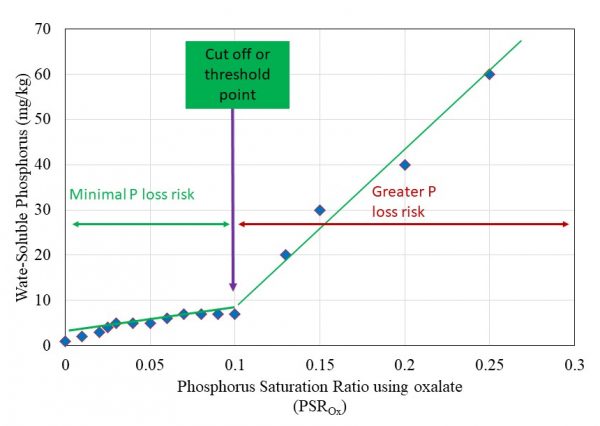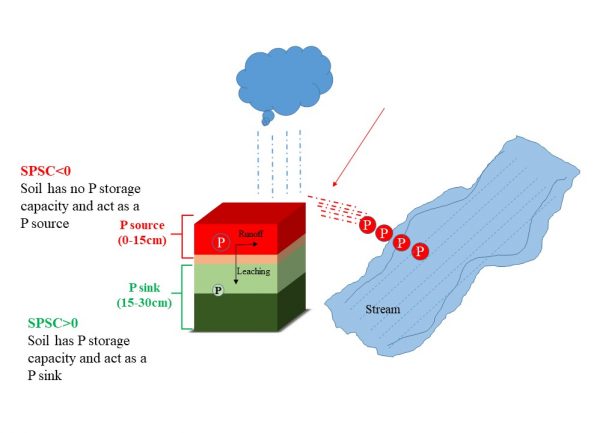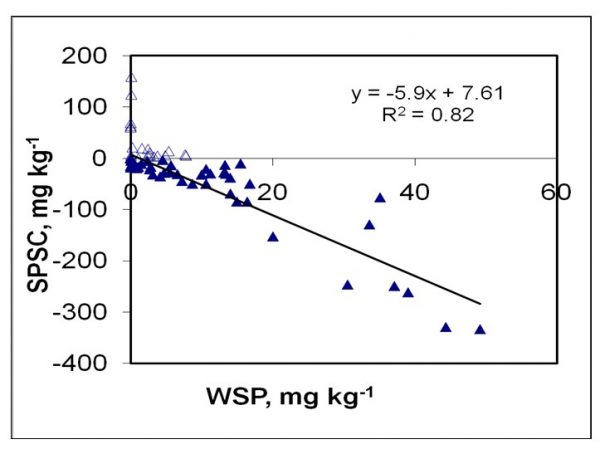Crop Production

Part of the Phosphorus Management series, this text provides soil and water professionals with methods to calculate soil phosphorus storage capacity and its potential use to minimize phosphorus loss risk.
Mehlich-1 is the agronomic soil test extractant used in Alabama to predict the fertility status of soil. It is also used in the Alabama phosphorus index as an input for predicting phosphorus loss risk from agricultural landscapes. Soil test phosphorus (Mehlich-1) fails to account for the phosphorus retentive capacity of the soil and hence may not be a suitable indicator for environmental purposes.
Soil phosphorus storage capacity was originally proposed by Nair and Harris1 to evaluate the potential phosphorus loss risk for Florida sandy soils. In this text you will learn about the concept of soil phosphorus storage capacity and its use for environmental phosphorus risk assessment.
Importance of Soil Phosphorus Storage Capacity for Alabama Soils
Soil phosphorus storage capacity is a quantitative approach. It provides a direct estimate of the amount of phosphorus that can be added to the soil before the soil becomes an environmental concern. Soil phosphorus storage capacity is a tool that can be used to determine phosphorus accumulation or buildup in soil due to past fertilizer or manure applications.
Current phosphorus recommendations in Alabama are based on soil fertility ratings. However, there may be soils that contain the following:
- low soil test phosphorus levels and low phosphorus retention capacity
- high or elevated soil test phosphorus with a remaining capacity to safely retain phosphorus
In either of these cases, determining phosphorus loss risk using soil test phosphorus ratings will be misleading.
Calculating Soil Phosphorus Storage Capacity
Soil phosphorus storage capacity is calculated based on a threshold phosphorus saturation ratio. There are three steps involved in the calculation of soil phosphorus storage capacity.
1. Determination of Phosphorus Saturation Ratio
Phosphorus saturation ratio is calculated as the ratio of phosphorus sorbed by the soil to the phosphorus sorption capacity. Phosphorus saturation ratio can be determined using oxalate, Mehlich-1, or Mehlich-3 extract as suggested by Nair and coworkers2 who derived it for sandy soils of Florida. The following equations can be used to determine phosphorus saturation ratio using oxalate (PSRox), Mehlich-1 (PSRM1), and Mehlich-3 (PSRM3) extractants.
PSRox = (Oxalate–P/31) ÷ [(Oxalate–Fe/56) + (Oxalate–Al/27)]
PSRM1 = (Mehlich-1–P/31) ÷ [(Mehlich-1–Fe/56) + (Mehlich-1–Al/27)]
PSRM3 = (Mehlich-3–P/31) ÷ [(Mehlich-3–Fe/56) + (Mehlich-3–Al/27)]
Oxalate–P: oxalate-extractable phosphorus
Oxalate–Fe: oxalate-extractable iron
Oxalate–Al: oxalate-extractable aluminum
Mehlich-1–P: Mehlich-1-extractable phosphorus
Mehlich-1–Fe: Mehlich-1-extractable iron
Mehlich-1–Al: Mehlich-1-extractable aluminum
Mehlich-3–P: Mehlich-3-extractable phosphorus
Mehlich-3–Fe: Mehlich-3-extractable iron
Mehlich-3–Al: Mehlich-3-extractable aluminum
Here P, Fe, and Al are expressed in mg kg-1 and are converted to moles by dividing with the corresponding atomic weight (P = 31; Fe = 56; and Al = 27).
2. Determination of Threshold Phosphorus Saturation Ratio
Threshold phosphorus saturation ratio is typically determined using the relationship between water- soluble phosphorus and phosphorus saturation ratio for a particular group of soil (figure 1). The point at which the phosphorus concentration in the soil solution abruptly increases is known as the change point. This change point is also known as the threshold phosphorus saturation ratio. It should be noted that threshold phosphorus saturation ratio is unique for a soil type and the extractant used. For example, the threshold phosphorus saturation ratio for Florida sandy soils is 0.08 using Mehlich-3 extract and 0.10 using oxalate extract.

Figure 1. Relationship between water-soluble phosphorus and phosphorus saturation ratio using oxalate extract (PSRox), illustrating the concept of threshold phosphorus saturation ratio
3. Determination of Soil Phosphorus Storage Capacity
Oxalate extractant is most widely used for determination of soil phosphorus storage capacity for acidic soils since oxalate extracts most of the reactive iron and aluminum present in the soil. Soil phosphorus storage capacity can be calculated using oxalate-extractable phosphorus, iron, and aluminum concentrations as follows:
SPSC (mg kg-1) = (Threshold PSRox – Soil PSRox) × [(Oxalate–Fe/56) + (Oxalate–Al/27)] × 31
Threshold PSRox: threshold phosphorus saturation ratio derived from water-soluble phosphorus and the phosphorus saturation ratio using oxalate extract (figure 1) for a population of soils from the same geographic region and textural properties
Soil PSRox: phosphorus saturation ratio of individual soil samples determined using oxalate extract
Oxalate–Fe: oxalate-extractable iron (mg kg-1)
Oxalate–Al: oxalate-extractable aluminum (mg kg-1)
Calculating Soil Phosphorus Storage Capacity Using Soil Test Data
Soil phosphorus storage capacity is typically calculated using oxalate-extractable phosphorus, iron, and aluminum values. However, soil phosphorus storage capacity can also be calculated from phosphorus, iron, and aluminum values derived from extractants such as Mehlich-1 and Mehlich-3 that are typically used for routine soil test analysis. This is done by using appropriate conversion factors as shown here:
SPSCM1 (mg kg-1) = (Threshold PSRM1 – Soil PSRM1 ) × [(Mehlich-1–Fe/56) + (Mehlich-1–Al/27)] × 31 × X
SPSCM3 (mg kg-1) = (Threshold PSRM3 – Soil PSRM3 ) × [(Mehlich-3–Fe/56) + (Mehlich-3–Al/27)] × 31 × Y
Threshold PSRM1: threshold phosphorus saturation ratio using Mehlich-1 extract
Soil PSRM1: phosphorus saturation ratio of an individual soil sample determined using Mehlich-1 extract
Mehlich-1–Fe: Mehlich-1-extractable iron (mg kg-1)
Mehlich-1–Al: Mehlich-1-extractable aluminum (mg kg-1)
X: conversion factor to calculate soil phosphorus storage capacity using Mehlich-1 extract
Threshold PSRM3: threshold phosphorus saturation ratio using Mehlich-3 extract
Soil PSRM3: phosphorus saturation ratio of an individual soil sample determined using Mehlich-3 extract
Mehlich-3–Fe: Mehlich-3-extractable iron (mg kg-1)
Mehlich-3–Al: Mehlich-3-extractable aluminum (mg kg-1)
Y: conversion factor needed to calculate soil phosphorus storage capacity using Mehlich-3 extract
The conversion factors are used primarily because Mehlich-1 and Mehlich-3 solutions do not extract phosphorus, iron, and aluminum with the same efficiency as oxalate solution. Conversion factor X or Y can be determined from a simple regression between soil phosphorus storage capacity calculated using oxalate, Mehlich-1, or Mehlich-3 parameters.
Interpreting Soil Phosphorus Storage Capacity for Environmental Phosphorus Loss Risk
Soil phosphorus storage capacity can be either greater than zero or less than zero. When soil phosphorus storage capacity is greater than zero (positive values), it means the soil has additional capacity to retain phosphorus, hence it will act as a phosphorus sink and will not be susceptible to phosphorus loss risk. However, when soil phosphorus storage capacity is less than zero (negative values), it means that the soil has no additional capacity to retain phosphorus and will act as a potential phosphorus source (figure 2).

Figure 2. Soil phosphorus storage capacity in 0–30 cm soil depth. The surface horizon (0–15 cm) has no remaining phosphorus storage capacity due to repeated phosphorus loading; hence surface horizon is acting as a P source. The subsurface soil (15–30 cm) still can retain phosphorus and is acting as a P sink.
Soil phosphorus storage capacity can be used as the capacity index of the soil to determine the safe remaining capacity of the soil to retain phosphorus. Predicting the phosphorus release potential from a soil can be useful in developing management practices.
The relationship between soil phosphorus storage capacity and water-soluble phosphorus for Florida sandy soil is illustrated in figure 3. Water-soluble phosphorus is an indicator of the amount of phosphorus that is susceptible to phosphorus loss in runoff water or leaching during a storm event. Hence, the relationship between soil phosphorus storage capacity and water- soluble phosphorus is important.

Figure 3. Relationship between soil phosphorus storage capacity and water-soluble phosphorus for surface soils of Florida sandy soils (credit: Chakraborty et al.3)
From Figure 3 we see that water-soluble phosphorus is minimal as long as soil phosphorus storage capacity is positive. However, water-soluble phosphorus increases linearly with increase in negative soil phosphorus storage capacity numbers. Soils with negative soil phosphorus storage capacity have a greater risk of dissolved phosphorus loss during storm events that can potentially have a negative impact on nearby water bodies.
References
1 Nair, V. D. and W. G. Harris. 2004. “A capacity factor as an alternative to soil test phosphorus in phosphorus risk assessment.” New Zeal. J. Agric. Res. 47, 491–497. https://doi.org/10.1080/00288233.2004.9513616
2 Nair, V. D., K. M. Portier, D. A. Graetz, and M. L. Walker. 2004. “An environmental threshold for degree of phosphorus saturation in sandy soils.” J. Environ. Qual. 33, 107–113. https://doi.org/10.2134/jeq2004.1070
3 Chakraborty, D., V. D. Nair, M. Chrysostome, and W. G. Harris. 2011. “Soil phosphorus storage capacity in manure-impacted Alaquods: Implications for water table management.” Agric. Ecosyst. Environ. 142, 167–175. https://doi.org/10.1016/j.agee.2011.04.019
Download a PDF of Phosphorus Management: Use of Soil Phosphorus Storage Capacity, ANR-2739.


